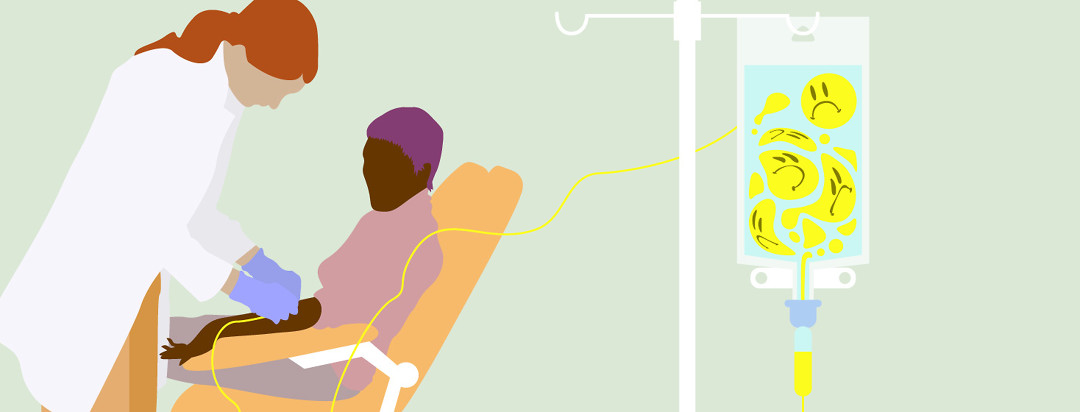My First Infusion Experience Wasn’t Right, But Ignorance Was Bliss
It’s been quite a few years since receiving my first biologic infusion. It wasn’t until my third infusion experience that I was informed by another patient advocate that the infusion center I was attending wasn’t taking proper care of me. Yikes!
Limited in infusion center choices
This particular infusion center wasn’t my first choice. However, back in 2013, my choices were limited. I tried my hardest to find an infusion center closer to home, but private infusion centers didn’t exist. All of the infusion centers close to my home were attached to medical practices.
Leading up to receiving insurance approval to start the infusible biologic, I learned that infusion centers in my region belonged to a doctor, practice, or medical group. And in order to become a patient of the facility, you must become a patient of one of the doctors operating the facility. This required a “new patient appointment,” which in my case lead to a costly co-pay. I was on a very tight budget and fixed income. Due to the type of insurance plan that I had, the cost of a new patient appointment with a specialist was high.
Out of frustration and concession, I opted to start my infusions with my GI’s office. Except it wasn’t with her office, it was with the oncology practice next door. The neighboring practices were run by a husband and wife. He was a GI, and she was an oncologist. The GI patients had to establish with her practice to utilize the infusion center. Therefore, I was still forced to pay that high-cost co-pay for a new-patient visit.
I was settling for a bad experience
My first three infusions went okay. They weren’t great, but I was able to walk out in one piece and considered that a win. That being said, I realize now that I settled for being treated poorly. The nurses never took my vitals past the time they set up my IV drip. They should have checked vitals regularly.
Due to the fact that I’m prone to allergic reactions, it’s disconcerting to think about no one paying attention. I was often nauseated but didn't know how to communicate that as the nurses seemed too busy to deal with me. Another thing I learned, later on, was that I had hives from the med since its start. There was a lack of communication and education from the nurses at this center. One nurse told me that I probably came in with hives, since she saw hives noted on my file. I let it go because I was afraid of the alternative.
Ignorance was bliss
From everything I know now, this was an unacceptable environment. My ignorance was bliss. At least they treated the chemo patients well.
There’s so much more I can say about that infusion center, but it’s not pertinent to what you should do to find the right one to meet your needs.
Questions when touring an infusion center
Cheat Sheet: Infusion Center Tour Questionnaire
- Tour the center
- Ask about safety protocols regarding vitals
- Learn the names of the nurses to talk to if you’re not feeling “quite right”
- Establish a plan if you’re not feeling right
- Inquire if additional fluids are offered post-infusion
- Question if they offer anti-nausea meds or if your doctor needs to put in an order for them ahead of time; the same goes for if pre-med orders are needed
Knowing what I know now, I tell everyone who is about to go on a tour of a potential infusion center to talk to the nurses and the office staff. Gage their friendliness. I also encourage them to use their ears and listen to how staff and nurses address difficult matters — over the phone and in person. You can learn a lot about a medical office when you listen to how staff members treat others.
Safety first
Another thing I recommend discussing is their safety protocols. You’ll want to know how often vitals are taken during your infusion session. For some people, their infusions are incredibly short; about 45 minutes because they are on a quick drip. For people like me who require a slower drip, infusions can last hours. So, vitals checks will be needed periodically.
A good example of why these protocols are useful is the following... When my vitals were taken every 15-to-20 minutes, trends in blood pressure drops and temperature spikes were spotted. They also clued me and the nurses to look for hives before I became itchy. Someone would help me disconnect from the wall and travel with my pole to the bathroom to look for hives in private. If I spotted hives, I would next head to the nurse practitioner’s office to start the action plan that she created for me. This new infusion center’s proactive practices enabled me to stay on the biologic longer than expected because they mitigated allergic reactions as they occurred.
If you could give one tip to someone starting their infusion center journey for Crohn’s disease or ulcerative colitis, what would it be?

Join the conversation